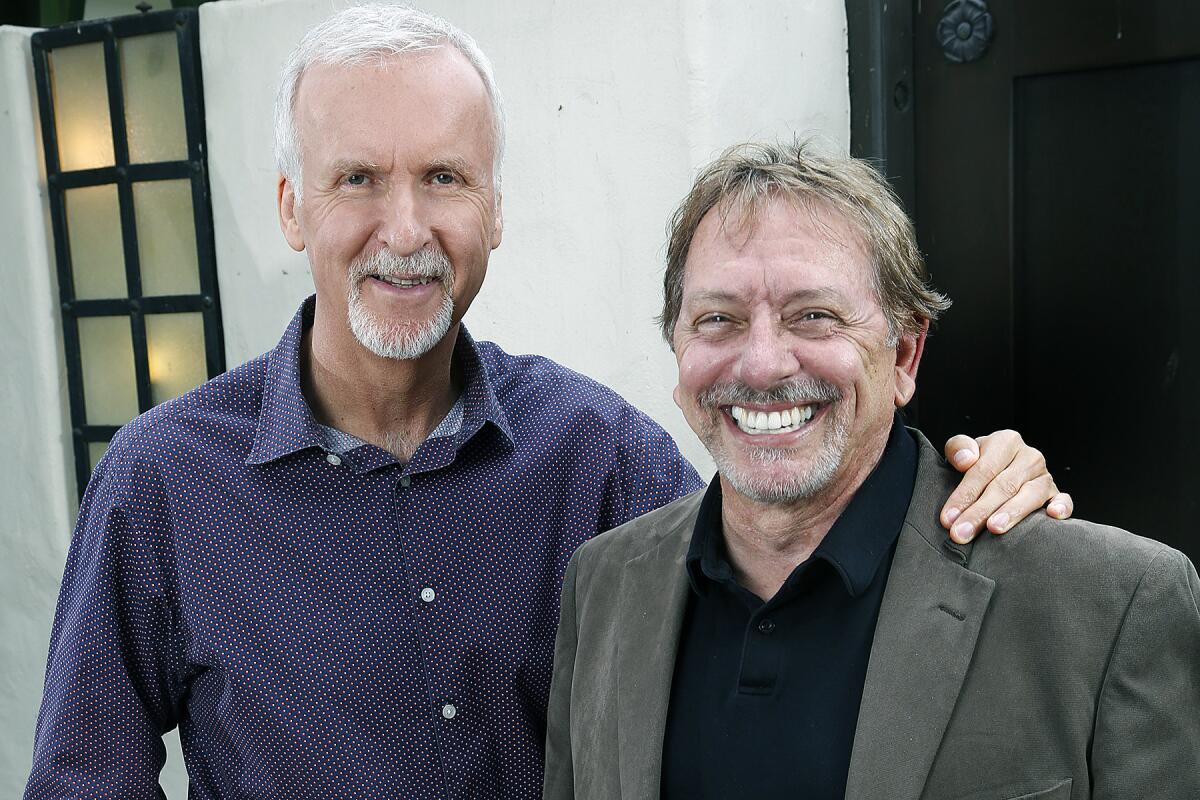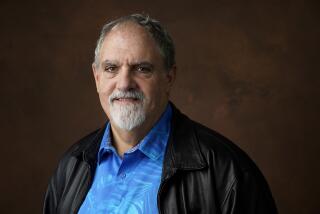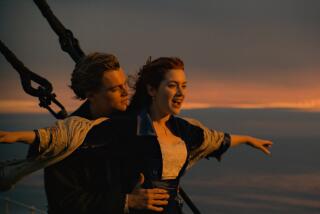Cameron shows his explorative side in ‘Deepsea Challenge 3D’

- Share via
In early 2012, James Cameron was bolted into the cramped pilot’s chamber of a torpedo-shaped submersible he had designed and hoped to ride in, alone, to the deepest point in the world’s oceans, a place no human had traveled to in 50 years. For the director of “Avatar,” it was his most technologically audacious project yet.
But as he sank to the bottom of the western Pacific on a test dive, Cameron’s life support system came loose from its mount and landed in his lap. On another test, his communication system failed — his ability to signal his crew above the sea lost. Cameron said he coped with the danger by running through checklists of safety procedures in his head.
“It’s very calming, very ritualistic,” Cameron said recently in an interview at his Malibu compound. “You try A, you try B, you try C, and hopefully you don’t ever get down to F, cause we all know what that stands for.”
It was a moment that summed up Cameron’s approach to filmmaking — and life itself. He’s daring but detailed, an adventurer who prides himself on being prepared and someone who always fiercely follows his own path up or down.
In March of that year, Cameron realized his dream, touching the sea floor in the Mariana Trench, a forbidding valley more than 36,000 feet down in the Pacific near Guam that has been reached only once before, by U.S. Navy Lt. Don Walsh and Swiss oceanographer Jacques Piccard in 1960. “Deepsea Challenge 3D,” a film opening Friday, documents the director’s often-harrowing journey to make the deepest solo dive in history, an expedition that included several false starts, rough seas and the tragic loss of two crew members in a helicopter accident.
Produced by National Geographic and directed by John Bruno, Ray Quint and Andrew Wight, “Deepsea Challenge 3D” also sheds some light on Cameron’s unconventional pastime. Though he has directed the two highest-grossing movies of all time (“Avatar” and “Titanic”) and is currently at work on three anticipated “Avatar” sequels, Cameron has said he finds his deepest pleasures far away from film sets, under the sea.
“I like exploration, and I have since I was a kid,” Cameron said. “For me, the big heroes were never sports heroes. They weren’t music gods. They were explorers. I was much more interested in Buzz Aldrin than John Lennon.”
At 59, Cameron has mellowed — nearly everyone who knows him says — from the hothead days of his youth. Thanks to a vegan diet he adopted a few years ago for environmental reasons, he’s lean and fit, his hair, formerly shaggy and blond, now close-cropped and white. But he’s still intense and loves to engage in long, geeky discussions about engineering, grabbing a pen to demonstrate the design of his sub and peppering his conversation with terms such as “syntactic foam” and “amphipod.”
A tinkerer and adrenaline seeker, Cameron is in the unusual position of being able to finance his fantasies thanks to his outsize Hollywood successes — and his extracurricular hobby of deep-sea diving has always influenced his day job.
He pitched the movie “Titanic,” which would go on to win 11 Oscars, in large part so that 20th Century Fox would finance a dive to the wreck of the British passenger liner, and he drew inspiration for the bioluminescent life in “Avatar” and the underwater traumas of “The Abyss” from dives he took.
“Working with Jim, it’s always an adventure,” said Bruno, a visual effects supervisor who has been part of Cameron’s professional circle since the 1989 underwater adventure film “The Abyss.” “Something’s coming our way that’s gonna be cool, and I know he can get it done. With other directors you wonder, if we start this, will it finish? I never worry about that with Jim.”
Devoted to Discovery
After 1997’s “Titanic,” Cameron withdrew from Hollywood for seven years, devoting himself to the discovery of new places and new technologies. At a stage of life when many of directors make their most lucrative films, he instead directed three deep-sea set documentaries that allowed him to indulge his childhood interests in diving and science, ultimately deciding he wanted to build his own sub.
In 2005, with the help of Australian cave diver Ron Allum, Cameron began actively designing the sub, called Deepsea Challenger. He shouldered much of the cost of the submersible and its expeditions himself, with support also coming from Rolex and National Geographic
“I thought, if I go out and start blabbering and getting a bunch of corporate sponsors, then it’s going to become public knowledge that we’re building this thing,” Cameron said. “I wanted to play it close to my vest in case we ever hit a wall and we couldn’t proceed.”
Cameron declined to say what the sub cost. Asked to give a range — perhaps in movie-budget parlance — he again demurred. “I don’t even know what indie movies cost these days,” he said. The valid comparison, he said, was to other subs that can travel to comparable depths.
“Those were all ... paid for by governments, and they cost in present value $100-$150 million,” he said. “Deepsea Challenger was a tiny fraction of that.”
Two teams of engineers, one in Silicon Valley and another in Sydney, Australia, completed the sub, which is 24 feet tall, weighs 11.5 tons and has a unique vertical design that allows it to move swiftly through the water.
In the summer and fall of 2009, as Cameron was putting the finishing touches on “Avatar,” he supervised the sub’s progress, spending lunch breaks on set Skyping into meetings with the engineers on his laptop.
In February 2012, the Deepsea Challenger crew was in the Pacific and about to embark on another test when the phone rang. Unbeknownst to Cameron, he said, Wight, his close friend and the leader of the expedition, and Mike deGruy, an underwater cinematographer, had taken a helicopter to film aerial shots of the sub. The helicopter crashed on takeoff, and both men died.
“Things get real real quick,” Cameron said. “There’s this sense of, what are we doing, why are we taking these stupid risks? And then over the course of the next few days we’re seeing, what are the impacts to the families?”
Ultimately the crew and the families of the two men determined that the expedition should go forward. “We all did some soul searching,” Cameron said. “The answer that came back from the group was, to honor what Andrew and Mike stood for as explorers we should complete the task.”
DeGruy’s family has since filed wrongful death lawsuits against three of Cameron’s companies, Wight’s estate and the helicopter manufacturer. Cameron described the suits as “pending” and declined to comment further on them.
After Wight’s death, Bruno stepped into his role, a job that put him in the unusual position of directing his notoriously controlling close friend of more than 25 years. The two have a brotherly rapport and a shared sense of adventure, but Bruno wasn’t sure how that would translate on the expedition or in the editing room, where he would ultimately end up with 1,200 hours of footage.
“At one point I had an idea for Jim to go somewhere on the deck and say something,” Bruno said. “I knocked on Jim’s door and said, ‘I have this idea.’ He goes, ‘Well, you’re the director. Tell me what to do, and I’ll do it.’ At that point I thought, ‘Oh, this is gonna be OK.’”
Among Bruno’s touches were including Cameron’s wife, actress Suzy Amis Cameron, in the film and asking her about the risks of the expedition. “I spent 45 minutes trying to crack her, like, ‘C’mon, you know you’re nervous, right?’” Bruno said. “She said, ‘No, he knows what he’s doing. I trust him.’ I thought, ‘This is why Suzy and Jim are together.’”
When Cameron finally made the dive, arriving in the deepest part of the Mariana Trench on March 26, 2012, his thrusters failed, forcing him to stay just three hours before returning to the surface. In that time, he filmed an octopus and collected samples from the ocean floor. At least 100 new species have been identified from the samples Cameron took — including one creature that produces a compound now used in clinical trials to treat Alzheimer’s disease.
The day after he completed his historic dive, Cameron boarded a plane for the London premiere of “Titanic 3D.” Now he’s in preproduction on three “Avatar” sequels that will shoot concurrently, the first of them due in December 2016.
It helps pay the bills.
“My purpose in making a movie is to make enough money so I can dive,” Cameron said.
More to Read
Only good movies
Get the Indie Focus newsletter, Mark Olsen's weekly guide to the world of cinema.
You may occasionally receive promotional content from the Los Angeles Times.











